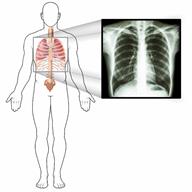Chest X-Ray: What to Expect
A chest X-ray is a test that uses radiation to make pictures of the organs in your chest, such as your lungs, heart, and ribs. X-rays can help your health care provider figure out why you have chest pain or a cough.
Chest X-rays are used to look for many health problems. These include:
Heart failure.
Broken ribs.
Breathing problems.
Cancer.
Tell a health care provider about:
-
Any allergies you have.
-
All medicines you take. These include vitamins, herbs, eye drops, and creams.
-
Any surgeries you've had.
-
Any medical problems you have.
-
Whether you're pregnant or may be pregnant.
What are the risks?
Your provider will talk with you about risks. These may include:
Being exposed to a small amount of radiation.
Being more likely to get cancer, if you're exposed to too much radiation. This can happen if you have too many X-rays.
What happens before?
You may be asked to:
Remove glasses, jewelry, and any other metal objects.
Undress from the waist up. You may be given a hospital gown to wear.
Wear a protective lead apron. This helps protect other parts of your body from radiation.
What happens during a chest X-ray?

-
You'll be asked to stand still as each picture is taken.
-
You'll be asked to take a deep breath and hold it for a few seconds.
-
The X-ray machine will make a picture of your chest. It won't hurt.
-
More pictures may be taken from other angles. If you can't stand, you may be asked to lie down.
These steps may vary. Ask what you can expect.
What can I expect after?
-
Your provider or an X-ray specialist called a radiologist will look at the X-rays.
-
You may go back to your normal activities, unless your provider says not to.
-
Ask when your X-ray results will be ready and how to get them. You may need to call or meet with your provider to get your results.
-
Your provider will tell you if you need more tests or another exam.
This information is not intended to replace advice given to you by your health care provider. Make sure you discuss any questions you have with your health care provider.
